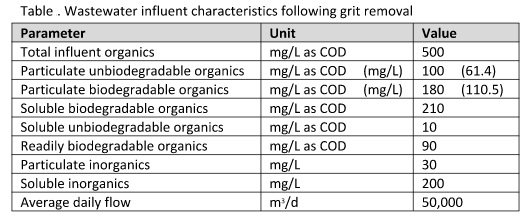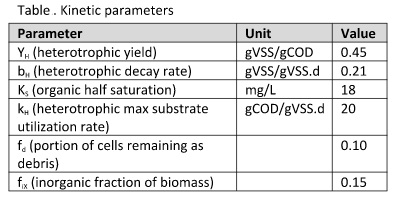QUESTION 1: DESIGN OF AEROBIC ORGANIC REMOVAL
In this problem you will do some basic calculations for an organic removal system. The reactor will be a single compartment completely mixed aerobic reactor with a typical hydraulic residence time (HRT) of 8 hours. The system does not use a primary sedimentation system. So you get a feeling of the size the system would likely serve a small city with around 250,000 residents.


Part A:
A wastewater has the characteristics described in Table below. Assume standard kinetic parameters for the heterotrophic organisms at 20 °C as provided in Table. If the regulatory authority has imposed an effluent discharge standard of 30 mg-BOD/L what SRT should we operate the system at to meet the organic removal requirements? Assume no loss of solids in the effluent and calculate for the exact SRT required (i.e. no spare capacity or buffer).
Hint: the answer is a very short SRT. Don’t be surprised, carry on to Part B.
Part B:
In reality we would only have no solids in the effluent if we had an MBR system that would block all particulate matter > 0.1 µm. In this case we would expect a very low effluent BOD associated only with soluble material not degraded. Recalculate for an effluent BOD of 1 mg/L. Now what is the required SRT?
Part C:
For a conventional clarifier system our effluent will contain small sludge particles. Let’s assume 30 mg-VSS/L escapes in the effluent, which is slightly high for normal flow conditions. As we are operating at a short retention time let’s also assume the active fraction of the MLVSS is quite high, say 70 % (raw sewage, no primary sedimentation). What is the required SRT to meet the discharge limit?
Part D:
What is our design biomass concentration (X) considering we are designing under Part C?
Hint: You need to carefully consider your influent organics – consider hydrolysis to be <1 day.
Part E:
What is the total MLVSS concentration in the reactor and the active fraction of volatile solids?
Part F:
What is our total MLSS concentration?
Hint: The exact equation was not given in class. However, based on the equation for Xv and by looking at the difference in the equations for daily sludge production for total solids and volatile solids it should be clear how to calculate this – there are two additions to the Xv equation.
Part G:
What is the sludge production per day (active, volatile and total)? Give the answer in a reasonable unit.
Part H:
What should be the waste sludge flow rate per day if we waste directly from the bioreactor instead of the clarifier sludge return?
Part I:
The waste flow is very high because we have very short SRT and low solids concentration in the reactor. While wasting directly from the reactor is preferred from process control for this case it is probably economically unfeasible. Given the low biomass concentration we can likely concentrate the return sludge flow by 500% in the clarifier. Given this what would be the new Qw if we wasted sludge from the clarifier sludge return line?
Part J:
Determine the oxygen demand from the sludge in the bioreactor and the oxygen supply required from the blowers. The oxygen transfer efficiency of the diffusers under field conditions in clean water is 25 % and the α factor is 0.6? Use reasonable units.
Part K:
What is the energy in terms of high heating value for the wastewater particulates (total) and the biomass (just bacteria) per kg if the organic components have the chemical formulae C10H19O3N and C5H7O2N respectively?
Hint: Remember to consider the inorganic fractions (ash).
Part L:
Roughly how much energy are we losing (as a percentage) by not incorporating a primary sedimentation tank. Assume a 40 % recovery of particulate solids in the primary sedimentation tank, that the SRT remains constant and that we are using anaerobic digestion – i.e. we are only interested in biodegradable organics.